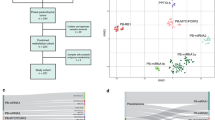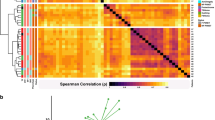Abstract
Human pineal parenchymal tumors (PPTs) are rare tumors, and little is known about their molecular pathogenesis. We used Atlas plastic human 8 K microarray analysis to identify the genes expressed in four human PPTs of different grades, in normal brain tissue and in a normal fetal pineal gland. We selected the most highly expressed genes in PPT (n=39) and compared their expression to that both in normal brain and fetal pineal gland. Nine genes were expressed more than twice as strongly and 3 at about half the level in PPT. Furthermore, real-time reverse transcription-PCR was performed to compare mRNA levels in the four PPTs, in four medulloblastomas (MBs) (the most common type of similar embryonal neoplasm in the cerebellum), and in normal brain, for 9 of the 39 genes. Among genes showing an expression similar to that obtained with microarray, puromycin-sensitive aminopeptidase and teratocarcinoma-derived growth factor 3 were up-regulated in PPT and in MB, and adenomatous polyposis coli like was down-regulated only in PPT. Up-regulated expression of chromosome 17 open reading frame 1A was seen in high-grade PPT and in MB, but not in lower grade PPT. In conclusion, our results identified a number of genes that are differentially expressed in PPT and MB, and some of them may serve as prognostic markers and can be used to define mechanisms of tumorigenesis.
Similar content being viewed by others
References
Aldosari N, Rasheed BK, McLendon RE, Friedman HS, Bigner DD, Bigner SH (2000) Characterization of chromosome 17 abnormalities in medulloblastomas. Acta Neuropathol 99:345–351
Bastianelli E, Pochet R (1995)Calbindin-D28k, calretinin, and S-100 immunoreactivities in rat pineal gland during postnatal development. J Pineal Res 18:127–134
Bello MJ, Rey JA, Campos JM de, Kusak ME (1993) Chromosomal abnormalities in a pineocytoma. Cancer Genet Cytogenet 71:185–186
Brockmeyer DL, Walker ML, Thompson G, Fults DW (1997) Astrocytoma and pineoblastoma arising sequentially in the fourth ventricle of the same patient. Case report and molecular analysis. Pediatr Neurosurg 26:36–40
Champier J, Jouvet A, Rey C, Guyotat J, Fevre-Montange M (2003) Differential somatostatin receptor subtype expression in human normal pineal gland and pineal parenchymal tumors. Cell Mol Neurobiol 23:101–113
Constam DB, Tobler AR, Rensing-Ehl A, Kemler I, Hersh LB, Fontana A (1995) Puromycin-sensitive aminopeptidase. Sequence analysis, expression, and functional characterization. J Biol Chem 270:26931–26939
Dario A, Cerati M, Taborelli M, Finzi G, Pozzi M, Dorizzi A (2000) Cytogenetic and ultrastructural study of a pineocytoma case report. J Neurooncol 48:131–134
Ellison D (2002) Classifying the medulloblastoma: insights from morphology and molecular genetics. Neuropathol Appl Neurobiol 28:257–282
Fischer H, Stenling R, Rubio C, Lindblom A (2001) Differential expression of aquaporin 8 in human colonic epithelial cells and colorectal tumors. BMC Physiology 1:1
Hlubek F, Spaderna S, Jung A, Kirchner T, Brabletz T (2004) Beta-catenin activates a coordinated expression of the proinvasive factors laminin-5 gamma2 chain and MT1-MMP in colorectal carcinomas. Int J Cancer 108:321–326
Hong SH, Nah HY, Lee JY, Gye MC, Kim CH, Kim MK (2004) Analysis of estrogen-regulatd genes in mouse uterus using cDNA microarray and laser capture microdissection. J Endocrinol 181:157–167
Honore B (2000) The hnRNP 2H9 gene, which is involved in the splicing reaction, is a multiply spliced gene. Biochim Biophys Acta 1492:108–119
Hsieh CM, Fukumoto S, Layne MD, Maemura K, Charles H, Patel A, Perrella MA, Lee ME (2000) Striated muscle preferentially expressed genes alpha and beta are two serine/threonine protein kinases derived from the same gene as the aortic preferentially expressed gene-1. J Biol Chem 275:36966–36973
Huang H, Mahler-Araujo BM, Sankila A, Chimelli L, Yonekawa Y, Kleihues P, Ohgaki H (2000) APC mutations in sporadic medulloblastomas. Am J Pathol 156:433–437
Jean S, Bideau C, Bellon L, Halimi G, De Meo M, Orsiere T, Dumenil G, Berge-Lefranc JL, Botta A (2001) The expression of genes induced in melanocytes by exposure to 365-nm UVA: study by cDNA arrays and real-time quantitative RT-PCR. Biochim Biophys Acta 1522:89–96
Jouvet A, Fevre-Montange M, Besancon R, Derrington E, Saint-Pierre G, Belin MF, Pialat J, Lapras C (1994) Structural and ultrastructural characteristics of human pineal gland, and pineal parenchymal tumors. Acta Neuropathol 88:334–348
Jouvet A, Saint-Pierre G, Fauchon F, Privat K, Bouffet E, Ruchoux MM, Chauveinc L, Fevre-Montange M (2000) Pineal parenchymal tumors: a correlation of histological features with prognosis in 66 cases. Brain Pathol 10:49–60
Kees UR, Biegel JA, Ford J, Ranford PR, Peroni SE, Hallam LA, Parmiter AH, Willoughby ML, Spagnolo D (1994) Enhanced MYCN expression and isochromosome 17q in pineoblastoma cell lines. Genes Chromosomes Cancer 9:129–135
Kees UR, Spagnolo D, Hallam LA, Ford J, Ranford PR, Baker DL, Callen DF, Biegel JA (1998) A new pineoblastoma cell line, PER-480, with der(10)t(10;17), der(16)t(1;16), and enhanced MYC expression in the absence of gene amplification. Cancer Genet Cytogenet 100:159–164
Kennerson ML, Nassif NT, Nicholson GA (1998) Genomic structure and physical mapping of C17orf1: a gene associated with the proximal element of the CMT1A-REP binary repeat. Genomics 53:110–112
Kleihues P, Burger PC, Scheithauer BW (1993) The new WHO classification of brain tumours. Brain Pathol 3 :255–268
Lastowska M, Cotterill S, Bown N, Cullinane C, Variend S, Lunec J, Strachan T, Pearson AD, Jackson MS (2002) Breakpoint position on 17q identifies the most aggressive neuroblastoma tumors. Genes Chromosomes Cancer 34:428–436
Lau WY, Lai PB, Leung MF, Leung BC, Wong N, Chen G, Leung TW, Liew CT (2000) Differential gene expression of hepatocellular carcinoma using cDNA microarray analysis. Oncol Res 12:59–69
Ljubimova JY, Lakhter AJ, Loksh A, Yong WH, Riedinger MS, Miner JH, Sorokin LM, Ljubimov AV, Black KL (2001) Overexpression of alpha4 chain-containing laminins in human glial tumors identified by gene microarray analysis. Cancer Res 61:5601–5610
Mena H, Nakazato Y, Jouvet A, Sheithauer BW (2000) Pineal parenchymal tumours. In: Kleihues P, Cavenee CW (eds) Pathology and genetics tumours of the nervous system. IARC Press, Lyon, pp 115–121
Michiels EM, Oussoren E, Van Groenigen M, Pauws E, Bossuyt PM, Voute PA, Baas F. (1999) Genes differentially expressed in medulloblastoma and fetal brain. Physiol Genomics 1:83–91
Morkel M, Huelsken J, Wakamiya M, Ding J, Wetering M van de, Clevers H, Taketo MM, Behringer RR, Shen MM, Birchmeier W (2003) Beta-catenin regulates Cripto- and Wnt3-dependent gene expression programs in mouse axis and mesoderm formation. Development 130:6283–6294
Nakagawa H, Koyama K, Monden M, Nakamura Y (1999) Analysis of APCL, a brain-specific adenomatous polyposis coli homologue, for mutations and expression in brain tumors. Jpn J Cancer Res 90:982–986
Nakagawa H, Koyama K, Murata Y, Morito M, Akiyama T, Nakamura Y (2000) APCL, a central nervous system-specific homologue of adenomatous polyposis coli tumor suppressor, binds to p53-binding protein 2 and translocates it to the perinucleus. Cancer Res 60:101–105
Nakagawa H, Murata Y, Koyama K, Fujiyama A, Miyoshi Y, Monden M, Akiyama T, Nakamura Y (1998) Identification of a brain-specific APC homologue, APCL, and its interaction with beta-catenin. Cancer Res 58:5176–5181
Nozaki M, Tada M, Matsumoto R, Sawamura Y, Abe H, Iggo RD (1998) Rare occurrence of inactivating p53 gene mutations in primary non-astrocytic tumors of the central nervous system: reappraisal by yeast functional assay. Acta Neuropathol 95:291–296
Pomeroy SL, Tamayo P, Gaasenbeek M, Sturla LM, Angelo M, McLaughlin ME, Kim JY, Goumnerova LC, Black PM, Lau C, Allen JC, Zagzag D, Olson JM, Curran T, Wetmore C, Biegel JA, Poggio T, Mukherjee S, Rifkin R, Califano A, Stolovitzky G, Louis DN, Mesirov JP, Lander ES, Golub TR (2002) Prediction of central nervous system embryonal tumour outcome based on gene expression. Nature 415:436–442
Rainho CA, Rogatto SR, Moraes LC de, Barbieri-Neto J (1992) Cytogenetic study of a pineocytoma. Cancer Genet Cytogenet 64:127–132
Rickert CH, Simon R, Bergmann M, Dockhorn-Dworniczak B, Paulus W (2001) Comparative genomic hybridization in pineal parenchymal tumors. Genes Chromosomes Cancer 30:99–104
Rickman DS, Bobek MP, Misek DE, Kuick R, Blaivas M, Kurnit DM, Taylor J, Hanash SM. (2001) Distinctive molecular profiles of high-grade and low-grade gliomas based on oligonucleotide microarray analysis. Cancer Res 61:6885–6891
Sallinen SL, Sallinen PK, Haapasalo HK, Helin HJ, Helen PT, Schraml P, Kallioniemi OP, Kononen J (2000) Identification of differentially expressed genes in human gliomas by DNA microarray and tissue chip techniques. Cancer Res 60:6617–6622
Sawyer JR, Sammartino G, Husain M, Linskey ME (2003) Constitutional t(16;22)(p13.3;q11.2 approximately 12) in a primitive neuroectodermal tumor of the pineal region. Cancer Genet Cytogenet 142:73–76
Scarlett CO, Blackshear PJ (2003) Neuroanatomical development in the absence of PKC phosphorylation of the myristoylated alanine-rich C-kinase substrate (MARCKS) protein. Dev Biol Res 144:25–42
Shen MM (2003) Decrypting the role of Cripto in tumorigenesis. J Clin Invest 112:500–502
Shimizu N, Ohta M, Fujiwara C, Sagara J, Mochizuki N, Oda T, Utiyama H (1991) Expression of a novel immediate early gene during 12-O-tetradecanoylphorbol-13-acetate-induced macrophagic differentiation of HL-60 cells. J Biol Chem 266:12157–12161
Sreekantaiah C, Jockin H, Brecher ML, Sandberg AA (1989) Interstitial deletion of chromosome 11q in a pineoblastoma. Cancer Genet Cytogenet 39:125–131
Takano K, Nakamoto T, Okajima M, Sudo A, Uetake K, Saitoh S (2003) Cerebellar and brainstem involvement in familial juvenile nephronophthisis type I. Pediatr Neurol 28:142–144
Thompson MW, Tobler A, Fontana A, Hersh LB (1999) Cloning and analysis of the gene for the human puromycin-sensitive aminopeptidase. Biochem Biophys Res Commun 258:234–240
Tobler AR, Constam DB, Schmitt-Graff A, Malipiero U, Schlapbach R, Fontana A (1997) Cloning of the human puromycin-sensitive aminopeptidase and evidence for expression in neurons. J Neurochem 68:889–897
Tsumanuma I, Sato M, Okazaki H, Tanaka R, Washiyama K, Kawasaki T, Kumanishi T (1995) The analysis of p53 tumor suppressor gene in pineal parenchymal tumors. Noshuyo Byori 12:39–43
Tsumanuma I, Tanaka R, Ichikawa T, Washiyama K, Kumanishi T (2000) Demonstration of hydroxyindole-O-methyltransferase (HIOMT) mRNA expression in pineal parenchymal tumors: histochemical in situ hybridization. J Pineal Res 28:203–209
Van Es JH, Kirkpatrick C, Wetering M van de, Molenaar M, Miles A, Kuipers J, Destree O, Peifer M, Clevers H (1999) Identification of APC2, a homologue of the adenomatous polyposis coli tumour suppressor. Curr Biol 9:105–108
Van Meir EG (1998) “Turcot’s syndrome”: phenotype of brain tumors, survival and mode of inheritance. Int J Cancer 75:162–164
Willis S, Hutchins AM, Hammet F, Ciciulla J, Soo WK, White D, Van der Spek P, Henderson MA, Gish K, Venter DJ, Armes JE (2003) Detailed gene copy number and RNA expression analysis of the 17q12–23 region in primary breast cancers. Genes Chromosomes Cancer 36:382–392
Yamane Y, Mena H, Nakazato Y (2002) Immunohistochemical characterization of pineal parenchymal tumors using novel monoclonal antibodies to the pineal body. Neuropathology 22:66–76
Acknowledgements
We are greatly indebted to Neurobiotec and to the neurosurgeons, especially J. Guyotat and C. Mottolese, at the Hôpital Neurocardiologique et Neurochirurgical Pierre Wertheimer, Lyon, for supplying the tumor samples. We also thank T. Barkas for linguistic help, and the Centre d’Imagerie de Laennec (CECIL) for the use of the FLA-8000 Image Analyzer. This work was supported by INSERM, the Association of Cancer Research (ARC 3277), and the Ligue Nationale contre le Cancer (185–2002).
Author information
Authors and Affiliations
Corresponding author
Rights and permissions
About this article
Cite this article
Champier, J., Jouvet, A., Rey, C. et al. Identification of differentially expressed genes in human pineal parenchymal tumors by microarray analysis. Acta Neuropathol 109, 306–313 (2005). https://doi.org/10.1007/s00401-004-0964-6
Received:
Revised:
Accepted:
Published:
Issue Date:
DOI: https://doi.org/10.1007/s00401-004-0964-6




